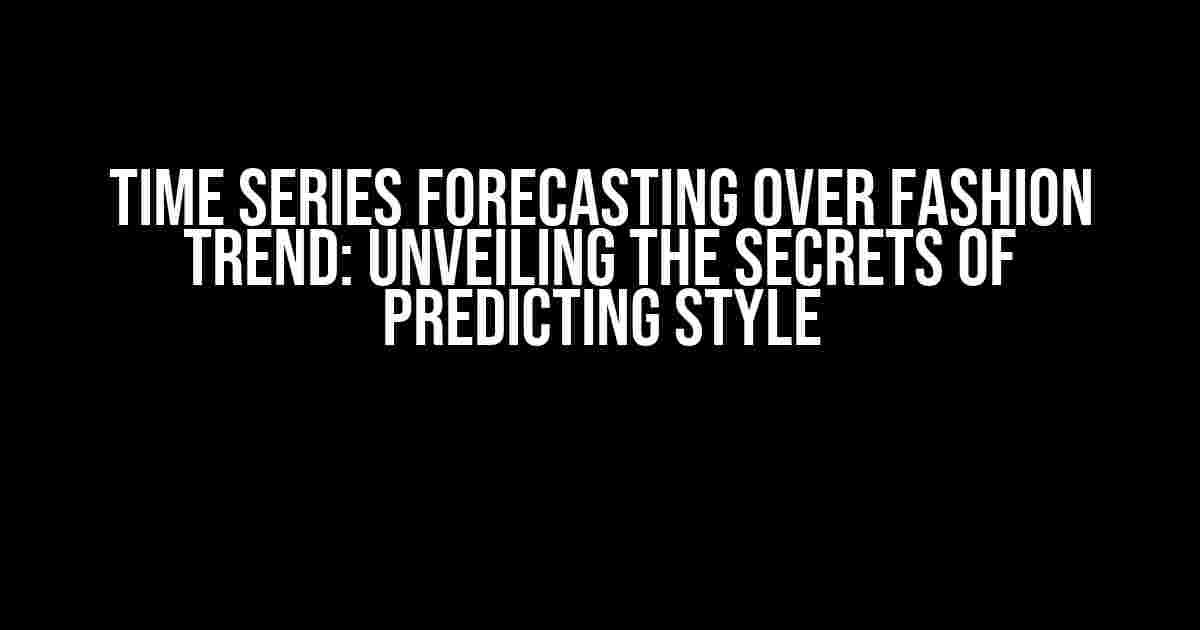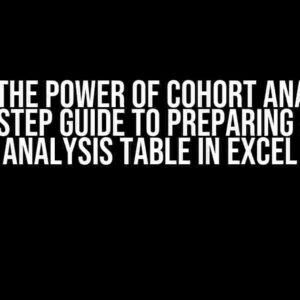As the world of fashion continues to evolve, understanding and predicting the next big trend has become a crucial aspect of staying ahead in the game. Time series forecasting, a statistical technique used to predict future values based on past data, has emerged as a powerful tool in the fashion industry. In this article, we’ll delve into the world of time series forecasting over fashion trends, exploring how it works, its applications, and providing step-by-step instructions on how to implement it.
What is Time Series Forecasting?
Time series forecasting is a statistical technique used to predict future values of a sequence of data points, typically observed at regular time intervals. This technique is widely used in various industries, including finance, economics, and, you guessed it, fashion! In the context of fashion, time series forecasting helps predict future trends, sales, and demand based on historical data.
Why is Time Series Forecasting Important in Fashion?
The fashion industry is known for its fast-paced and ever-changing nature. Trends come and go, and staying on top of them can make all the difference between success and failure. Time series forecasting helps fashion brands and retailers:
- Anticipate and prepare for seasonal fluctuations in demand
- Identify emerging trends and make informed design decisions
- Optimize inventory management and reduce waste
- Improve supply chain efficiency and reduce costs
Types of Time Series Forecasting Models
There are several types of time series forecasting models, each with its strengths and weaknesses. Here are some of the most popular ones used in fashion:
- Autoregressive (AR) Model: This model uses past values to forecast future values, assuming a linear relationship between them.
- Moving Average (MA) Model: This model uses the moving average of past errors to forecast future values, assuming a random component in the data.
- Autoregressive Integrated Moving Average (ARIMA) Model: A combination of AR and MA models, this model is widely used in fashion due to its ability to handle non-stationary data.
- Exponential Smoothing (ES) Model: This model uses weighted averages of past observations to forecast future values, giving more importance to recent data.
Step-by-Step Guide to Implementing Time Series Forecasting in Fashion
Now that we’ve covered the basics, let’s dive into the step-by-step process of implementing time series forecasting in fashion:
Step 1: Collect and Preprocess Data
Gather historical data on fashion trends, sales, and demand. This data can come from various sources, including:
- Social media analytics tools
- Google Trends
- Sales data from e-commerce platforms or brick-and-mortar stores
- Fashion blogs and influencer reports
import pandas as pd
data = pd.read_csv('fashion_data.csv')
Step 2: Visualize the Data
Visualize the data using plots and charts to identify patterns, trends, and seasonality:
import matplotlib.pyplot as plt
plt.plot(data['date'], data['sales'])
plt.xlabel('Date')
plt.ylabel('Sales')
plt.title('Fashion Sales Over Time')
plt.show()
Step 3: Choose a Forecasting Model
Select a suitable forecasting model based on the characteristics of your data. For example, if your data exhibits strong seasonality, an ARIMA model might be suitable:
from statsmodels.tsa.arima_model import ARIMA model = ARIMA(data, order=(1,1,1))
Step 4: Train and Evaluate the Model
Train the model using historical data and evaluate its performance using metrics such as mean absolute error (MAE) and mean squared error (MSE):
model_fit = model.fit(disp=-1)
forecast = model_fit.forecast(steps=30)
print('MAE:', model_fit.aic)
print('MSE:', model_fit.bic)
Step 5: Generate Forecasts
Use the trained model to generate forecasts for future fashion trends and sales:
forecast_data = model_fit.forecast(steps=30) print(forecast_data)
Real-World Applications of Time Series Forecasting in Fashion
Time series forecasting has numerous applications in the fashion industry, including:
| Application | Description |
|---|---|
| Inventory Management | Forecasting demand to optimize inventory levels and reduce waste |
| Supply Chain Optimization | Predicting demand to optimize production and shipping schedules |
| Trend Prediction | Identifying emerging trends to inform design decisions and stay ahead of competitors |
| Pricing and Revenue Management | Forecasting demand to optimize pricing and revenue strategies |
Challenges and Limitations of Time Series Forecasting in Fashion
While time series forecasting is a powerful tool in fashion, it’s not without its challenges and limitations:
- Data quality and availability can impact forecasting accuracy
- Handling complex and non-linear relationships between variables
- Dealing with high-dimensional data and feature selection
- Addressing concept drift and changes in consumer behavior
Conclusion
Time series forecasting is a valuable technique in the fashion industry, enabling brands and retailers to anticipate and prepare for future trends, optimize inventory and supply chain management, and make informed design decisions. By following the step-by-step guide outlined in this article, fashion professionals can harness the power of time series forecasting to stay ahead in the fast-paced world of fashion.
Remember, time series forecasting is not a crystal ball, but rather a powerful tool that can help you make data-driven decisions and stay ahead of the competition. So, get forecasting and unlock the secrets of predicting style!
References
- Hill, R. C., & Trench, M. (2011). Time series forecasting for fashion demand. Journal of Fashion Marketing and Management, 15(2), 152-164.
- Kastens, B. (2018). Time series forecasting in fashion: A systematic review. International Journal of Fashion Design, Technology and Education, 11(1), 3-14.
Frequently Asked Question
Get ready to stay ahead of the fashion curve with our time series forecasting guide! Here are some frequently asked questions to get you started:
What is time series forecasting in fashion, and how does it work?
Time series forecasting in fashion involves analyzing past sales data and trends to predict future demand for specific fashion items. It’s like having a crystal ball that shows you what’s hot and what’s not! By applying statistical models and machine learning algorithms to historical data, you can identify patterns, trends, and seasonality, and make informed decisions about inventory management, pricing, and marketing strategies.
Why is time series forecasting important in the fashion industry?
Time series forecasting is crucial in fashion because it helps brands and retailers stay ahead of the competition, minimize stockouts, and reduce waste. With accurate forecasting, you can ensure that you have the right products, in the right quantities, at the right time, and at the right price. It’s like having a superpower that helps you navigate the ever-changing fashion landscape!
What types of data are used in time series forecasting for fashion?
Time series forecasting in fashion typically involves analyzing historical sales data, such as transactional data, customer data, and product data. You can also incorporate external factors like weather data, social media trends, and economic indicators to improve the accuracy of your forecasts. It’s like collecting puzzle pieces to create a complete picture of your fashion brand’s performance!
How can time series forecasting help with inventory management in fashion?
Time series forecasting helps with inventory management by predicting demand for specific fashion items, allowing you to optimize your stock levels, reduce overstocking, and minimize stockouts. You can also use forecasting to identify and respond to changes in demand, ensuring that you always have the right products in stock to meet customer demand. It’s like having a magic inventory wand that makes stock management a breeze!
Can time series forecasting be used for long-term fashion trend prediction?
While time series forecasting is typically used for short-term demand forecasting, it can also be used to identify long-term fashion trends. By analyzing historical data and identifying patterns, you can predict which fashion trends will endure and which will fade away. It’s like having a fashion crystal ball that shows you the future of style!


